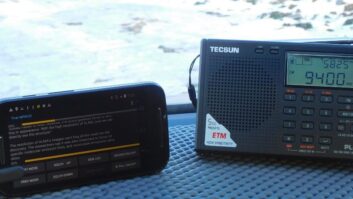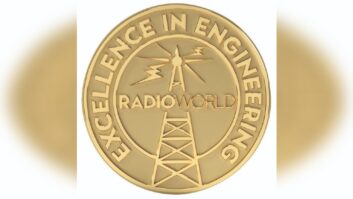(click thumbnail)Fig. 1: I think that I shall never see a cell site lovely as a tree.From the “why didn’t I think of that” department: Have you spotted the new cellular “trees” sprouting up across our country? I guess these are in response to environmentalists who feel that regular cellular towers are ugly.
Mark Bohnett of WOLC(FM) in Princess Anne, Md., sent in Figs. 1 and 2. He calls them “Ugly Trees,” and I have to agree.
I wonder if the next step will be to require RFR studies for the birds and squirrels that will start nesting in the artificial branches.
From the response to the last few columns, it seems like we all enjoy a good story. Here are a couple more.
Dave Sanford once was chief of a station in Prescott, Ariz. One Sunday morning the transmitter went off. About 4 hours later, the disc jockey’s replacement came in and asked how long the station had been off the air.
The disc jockey who was “on the air” didn’t know the station was down. His relief called Dave at church, and Dave walked him through turning on the filaments, waiting a couple minutes, then turning on the plates.
(click thumbnail)Fig. 2: Protect your Telos Zephyr power supply with wire ties looped around the supply and fastened to the body of the unit.
When Dave asked about the speakers in the control room, the previous operator said that right after he came in, they all of a sudden changed to static. So he switched over to program so he could hear what he was doing.
When Dave asked about the remote-control readings, the talent replied that they all said zero or had minus signs in front of them, so he just copied down what the overnight operator had for readings.
The jock added that listeners had called in complaining all morning that they couldn’t hear the station, but the jock said that since he could hear the station just fine (in program), he ignored their calls.
In a similar vein: Vic Jester now works for Radio One in Atlanta. He was a contract engineer for a 1 kW daytimer some years ago. One Saturday he called in just to check on the station. The jock said everything was fine now, but the station had been off the air earlier that afternoon.
When asked what the problem was, the jock replied, “I’m not really sure. When we went off, I pressed the button labeled ‘PGM’ on the monitor module and we just came back on.”
And then there are the tales about promotions and climbing the corporate ladder.
Friend Weller writes that early one morning his sleep was interrupted by the telephone. The voice of the new overnight announcer informed him that the station was off the air and demanded to know what Friend, as the chief, was going to do about it.
Sadly, this air talent had been hired more for her “eye-candy” appeal at remote broadcasts than her experience in radio. In the prior week, there had already been more than one run-in over why the control room speakers had to mute when the mike was opened.
As is his style, Friend responded calmly by beginning to ask the usual questions, starting with, “Have you tried to turn the transmitter back on?” The announcer scoffed at having to do such a thing, to which Friend replied that if the transmitter were on, she would be back on the air and he could go back to sleep.
“Transmitter!” she retorted, “What transmitter? I thought they only used those things in the olden days.”
A week later, she was promoted to evenings.
At least that was the end of the overnight calls.
The stories are funny, but they point to an important troubleshooting tip: don’t assume anything. It’s like when you call the Computer Help Desk and the first thing they ask you is if the computer is plugged in.


. . .
One of the great things about working with a big company is the resources available to you. I know the engineers among the big groups appreciate this, and it’s no different with a broadcast equipment manufacturing company.
John Stevens is Harris’ digital applications engineer, based in Mason, Ohio. Perhaps you had a chance to chat with him at the NAB.
He passed along a Web site that is chock-full of information for beginner and veteran engineers. The subject matter runs the gamut from electrical to electronic topics and includes some great links. The subjects are presented in a tutorial manner, and are easy to understand, and quick to read. Bookmark this site for reference: www.williamson-labs.com.
. . .
Remote season has arrived. Fig. 3 shows a good way to protect your Telos Zephyr power supply so it won’t get lost or banged around.
Some wire ties looped around the supply and fastened to the body of the Zephyr keep the supply snug. Thanks to Roger duFault at WPGC for this tip.












